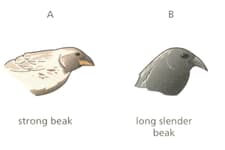EASY
Lower Secondary Stage 9
IMPORTANT
Earn 100
Aristotle was a Greek scientist who developed the first classification system. He divided all the known organisms into two groups- the plants and the animals. Aristotle then divided each animal group into three smaller groups- land, water and air. Birds, bats and flying insects were grouped together as 'air animals'. We now know that Aristotle's classification system does not work. It groups organisms that are completely different to one another in the same group. Explain why Aristotle's classification of 'air animals' does not work.

Important Questions on Variation and Inheritance
MEDIUM
Lower Secondary Stage 9
IMPORTANT
Which of the following best describes a gene? Tick one box only.
MEDIUM
Lower Secondary Stage 9
IMPORTANT
In the table below, put ticks in the correct columns to show whether the characteristic is: inherited only, acquired only, inherited, and acquired. The first one has been done for you.
| Characteristics | Inherited only | Acquired only | Inherited and acquired |
| Skin colour |  |
||
| Body mass | |||
| A scar | |||
| Shape of ear |
MEDIUM
Lower Secondary Stage 9
IMPORTANT
Explain why identical twins look alike.
EASY
Lower Secondary Stage 9
IMPORTANT
Give two examples of inherited variation seen in cats.
MEDIUM
Lower Secondary Stage 9
IMPORTANT
Robert Bakewell is known for his work on selectively breeding in the s. He selectively bred cattle to produce a breed that ate less food and put on more weight than any other breed. Suggest why the process of selectively breeding is still popular across the world today.
MEDIUM
Lower Secondary Stage 9
IMPORTANT
Charles Darwin caught different types of finches on the Galápagos Islands in the Pacific Ocean. He brought them back to London where they were analysed by John Gould. Each species had a different type of beak. The diagram shows two of these finches. Complete the table to show:
- The letter of the finch best suited to each type of food.
- An explanation of how the beak is adapted to the food.

| Finch | Main food source | Explanation |
| Nectar from inside flowers | ||
| Seeds that need to be crushed |
MEDIUM
Lower Secondary Stage 9
IMPORTANT
Describe one similarity and one difference between selective breeding and natural selection.
MEDIUM
Lower Secondary Stage 9
IMPORTANT
Lemmings are furry rodents naturally found in the Arctic tundra. In a population of lemmings was taken from the Arctic to an area with a warmer climate. The lemmings were left to live and reproduce in the new area. The population of lemmings was revisited years later. Some information about the lemmings is shown in the table:
| Year | Average fur length of lemming(mm) |
